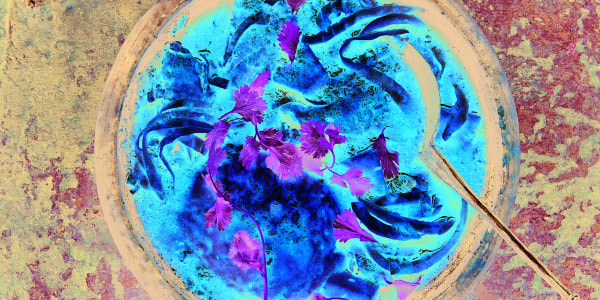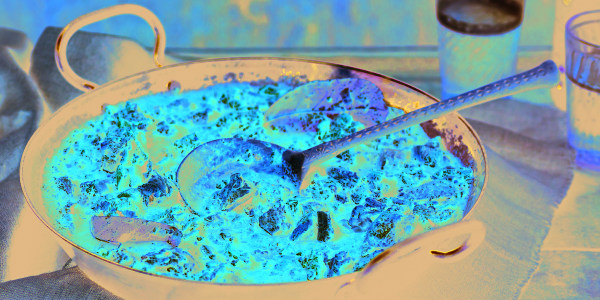An ingredient I like to think of as the lesser-known fourth member of the Fugees, prekese has that deep, raw, stinky funk, a growling soul and a hip-hop attitude that comes dressed to impress. It can seem standoffish — seriously, it’s stinky as hell — but it mellows in application, adding a savory, unctuous depth of flavor as it lyrically expands your cooking.
What is prekese?
The purplish-brown fruit of the aidan tree, prekese peaks from September to December. Long, curving pods hang from the tips of branches clad with small green leaves and flowers that shift from creamy pink to deep orange in spring.
Prekese — also known as prɛkɛsɛ (soup perfume), oshosho, osakirisa, ubukirihu or aidan fruit — is a medicinal plant of the aidan tree, commonly used as a cooking spice which adds a slightly sweet yet stringent flavor that imbues dishes and drinks with a fragrant, sugary aroma. Native to West Tropical Africa, aidan trees, which can grow up to 25 meters (~82 feet) tall, are full of therapeutic qualities. The fruit has long been celebrated for its anti-inflammatory properties and a host of other health benefits.
Prekese is known botanically as Tetrapleura tetraptera, a species of flowering plant in the pea family. Aidan trees thrive in secondary forests and rainforests, but they can also be found in savanna woodlands and occasionally African plains from across West Africa, Sudan and Uganda to Kenya, Angola and Tanzania.
The pods of the aidan tree comprise of four perpendicular ridges resembling wings, two of which become woody while the remaining two consist of sugary pulp and hard, black seeds, which contain oil. The pods can be dried for year-round use, or chopped or crushed for adding to tinctures, drinks or food.
How is prekese used traditionally?
While prekese's medicinal qualities have been documented by scientific studies since the 1940s, the plant has been known and utilized in Africa for its therapeutic properties for centuries. The stem, root, leaves, bark and pods of the Adrian tree can be utilized — whether soaked, squeezed, crushed, extracted or incorporated into a variety of herbal concoctions or soups.
Prekese has also been used to create skin-soothing soaps and balms, and when dried and ground into a fine powder, the plant can be included with palm kernel oil or shea butter for dermatological care. The fruit and flowers, too, have made their way into locally-made products like perfumes and can serve as a natural mosquito repellant.
Prekese has many traditional food and beverage uses as well, commonly used as a cooking spice in soup, sprinkled on meat such as lamb or venison or infused into drinks.
What are the health benefits of prekese?
Whether incorporated into meals for its health benefits, or consumed exclusively for medicinal purposes, prekese extracts have been credited with healing a variety of ailments. Some practitioners will combine it in elixirs in the hopes of preventing certain ulcers, inhibiting bacterial growth, improving asthma and promoting blood flow. to help prevent certain ulcers, inhibit bacterial growth, improving asthma and promote blood flow. Prekese is rich in essential phytochemicals and nutrients like potassium, iron, magnesium, phosphorus, zinc, copper, calcium and vitamin C. When consumed regularly, it has been said to help with diabetes and glucose levels, reducing hypertension, lowering blood pressure, providing essential postpartum nutrients that restore blood loss and produce milk, relieving fevers and showing wound-healing effects.
What are some ways to cook with prekese?
Prekese can be prepared in foods ranging from soups and stews — such as my recipe for Goat Ragu with Prekese — to desserts and baked goods. The pods can be crushed, ground or broken into small pieces for such purposes, as well as dropped in whole while cooking and removed before eating. When put to work in cooking purposes, the plant — rich with sugars, tannins, flavonoids and starch — gets dried then grated or boiled, oftentimes into banga soup, pepper soup, palm nut soup or light soup. It can also be used to flavor drinks, sodas and teas that offer health benefits. And it can be soaked in alcohol, like gin distilled from sugarcane, to create traditional appetizers and beverages.
Unfortunately, though, aidan trees are in danger of disappearing. The alarming rate of deforestation in many of the regions where the trees flourish — either in forest conversion for cocoa and other farming purposes or mining in forest reserves — have put them at great risk. The trees, which grow best in mixed forest with greater biodiversity, often die after a decade in areas converted for single-purpose growth.
So, if we want to continue to appreciate prekese's many health benefits, as well as savor its sweet, tangy taste, the natural habitats of these trees must be conserved and protected. One way to preserve prekese from extinction might be to cook with it — to use it regularly in order to demonstrate a market for its longevity. As usual, I encourage you to buy Black — specifically African — when seeking out any ingredients from the continent. Check out AfriqueCart on Etsy to purchase your prekese and support a young African food entrepreneur working to keep our culture alive.
What is prekese? This funky ingredient belongs in soups and stews - TODAY
Read More



No comments:
Post a Comment